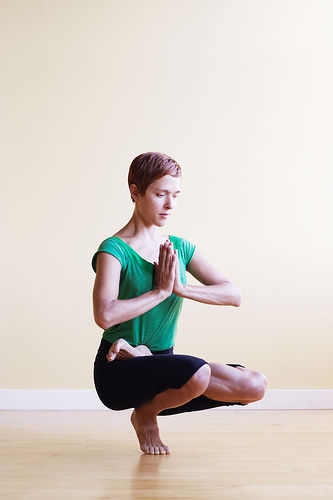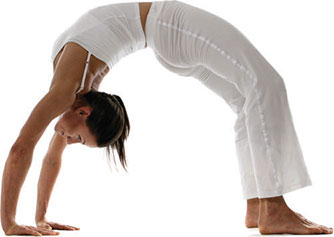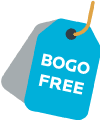Most exercise enthusiasts acknowledge that yoga isn’t the most comprehensive workout. Yet even though it’s not optimal for increasing strength, muscle, or cardiovascular health in isolation, it’s mindful physical movement.
What is yoga?
The word yoga comes from the Hindi yoga, originally from pre-Indo-European yeug, meaning “union” or “to join.”
Eastern vs Western styles
Classic yoga from the east follows ancient Hindu discipline, incorporating asanas (physical exercises and postures), pranayama (breathing techniques), and meditation designed to move someone towards peace of mind and spiritual enlightenment. For Hindus and Buddhists, the goal of yoga is union with Brahman (the eternal or absolute) and Atman (your true self) – not so much about sculpting a “yoga booty.” Yoga is not a religion, but many followers use it to enrich their spiritual practice.
In the west, modern yoga styles are generally thought of as physical exercises to build flexibility and strength.
 |
 |
East meets West…
Yoga history
Yoga practice can be traced back 5000 years to Indus-Sarasvati civilizations in India. (And we thought using free weights was old school.)
A Hindu teacher named Patanjali was said to have recorded the first principles of yoga in religious scriptures known as the Yoga Sutra. Many forms of yoga have been developed since – each focusing on a new realm of personal development.
Hatha yoga came to the west in the 1920s thanks to T. Krishnamacharya and remains the most popular style today.
Why yoga is important
Yoga’s popular
The number of people practicing yoga in the U.S. has more than doubled since 1998, from 7 million to 15 million.
Nearly 5% of U.S. businesses offered yoga at the workplace in 2008. Approximately 75% of U.S. health clubs offer yoga instruction.
Yoga may make you healthier
Yogis claim numerous physical and psychological benefits result from yoga. But is there any data showing this?
Well, the double-blind test, adored by many Western health professionals, isn’t possible with yoga. If one group in a study is practicing healthy yoga, it’s hard to recruit a blind group that isn’t, and doesn’t know it. Still, yoga data does exist.
Heart disease
Yoga may help reverse heart disease. Well, when combined with aerobic exercise and a low-fat plant-based diet. The author of one study said, “Adherence to the yoga and meditation program was as strongly correlated with the changes in the amount of blockage [in the arteries] as was the adherence to diet.” Yoga may help to control inflammation throughout the body as well.
Pain, balance and flexibility
What is one of the greatest fears among the elderly? Falling. Yoga can help with balance in older folks. Just two sessions of Hatha yoga per week can increase stability. Before you dismiss yoga as a Friday night nursing home activity, yoga can improve balance in people under 60 years old too.
Yoga interventions have been shown to be effective for alleviating back pain and symptoms of carpal tunnel syndrome.

Stress and mood
Yoga has long been used for relieving stress and improving mood. Plus, since some people overeat due to stress, conquering stress with yoga might indirectly improve nutrition.
Women undergoing treatment for cancer have found yoga to be helpful for mood and controlling stress levels.
Yoga may help control anxiety and the meditation aspect of yoga can assist those in prison with self-control.
Most yoga is parasympathetic dominant, which may promote recovery from intense workouts. See the following for more on the importance of parasympathetic activities:
Disordered eating and weight
Body image disturbances and disordered eating continue to increase. Authentic yoga studios have no mirrors. Rather, students’ awareness is tuned to internal sensations. Yoga offers a non-verbal adjunct to standard eating disorder therapy and provides an opportunity to unite the physical body with inner experience.
When someone encounters awkward or painful postures in yoga, they are trained to observe the tension and breathe while coaxing their muscles or joints open, or just accept it as is. This same technique can be applied to other uncomfortable situations, such as a craving for junk food or drugs.
Since yoga can help to unite the mind and body, it can be useful in regulating appetite, decreasing food preoccupation, enhancing body awareness, and boosting body satisfaction. The longer one participates in yoga, the more self-awareness and positive impact on body image/eating they develop (i.e., years may be more effective than months).
Yoga can help eliminate binge-eating patterns. This may be due to the meditation aspect and ability to heighten mindfulness.
People who practiced yoga regularly for four years or more gained less weight as they got older. Moreover, overweight individuals who practiced yoga for four or more years managed to lose weight over a 10-year period.
Menopause
Yoga may be useful for alleviating symptoms of menopause.
Lymphatic system
Exercise, particularly yoga can help increase lymph drainage.
Epilepsy
There have been few reliable studies using yoga for epilepsy, but the results are encouraging. Yoga may stimulate the vagus nerve, which can decrease seizure frequency.
Getting injured
This just in: You can get injured doing yoga (like most physical endeavours).
13,000 Americans have visited the ER or doctor’s office during the past three years due to yoga-related injuries. That’s outrageous. Oh, wait a minute, no it’s not. 7.6 million ER visits each year are associated with alcohol.
Yoga is dangerous for people who do too much, too soon — the folks who haven’t stretched since high school band camp and want to show off for the cute girl/guy in the front row of Saturday morning yoga. Goodbye hamstring attachment site; hello physical therapy office. You’ll see case reports of serious injuries in those attempting advanced yoga poses when they shouldn’t be.
Those who are pregnant or have glaucoma should check themselves before trying to perform any postural yoga that increases pressure in the torso and head (like inversions).

Finally, folks with hypermobility of the lumbar spine (lower back) might increase their risk of low back problems and vertebral stress fractures with poses that involve excessive hyperextension of the lumbar spine, like this:

What you should know about yoga
Be aware of your yoga instructor’s background, qualifications, experience and training. Check their style and figure out who attends their classes. Just like a coach, teacher or trainer, we all have different preferences.
Yoga styles
Virtually all forms of yoga can be traced back to the four cornerstones: ritual, knowledge, devotional and tantric.
There are many varieties of yoga to choose from. Here’s a brief description of the more popular styles.
Ayurveda
Ayurvedic yoga combines Asanas, Pranayama, and meditation. Asanas strengthen muscles, improve flexibility, and rejuvenate the body. The aim of this style is to bring natural order and balance to hormones and metabolism. Adherents see this as a natural way to treat stress-related disorders.
Anusara
All levels are invited here. There is a focus on creative freedom and individuality – so get ready to express yourself. This is a “recent” style started in 1997. You’ll probably be doing some chanting here.
Ashtanga
This discipline involves synchronizing the breath with a progressive series of postures. The result is internal heat and sweating, which detoxifies the muscles and organs.
Adherents of Ashtanga, which is the most vigorous form practised, claim that the results include improved circulation, a light and strong body, and a calm mind. It is fast paced and a high strength to bodyweight ratio is necessary.
Bikram (often called “hot”)
Imagine doing yoga in a dry sauna. Bikram yoga is a series of 26 traditional Hatha yoga postures and breathing exercises, all performed in a heated room. The entire workout takes approximately 90 minutes, and will leave you sweaty.
https://www.youtube.com/watch?v=wEzznV7LlyA
Hatha/Ananda (often called “restorative”)
Hatha yoga is the most commonly practised form in the West – its combination of Asanas, Pranayama and meditation providing a balanced approach to physical and mental health. It is the least strenuous yoga. If you have exercise ADD, you may get bored. If you are intimidated and figuring out where to start with yoga, this is the class.
Iyengar
This is purist yoga, named after B.K.S. Iyegar. It has a slow pace with a priority of mastering poses in isolation. Feel free to get assistance from blocks, straps or pads. Good for learning yoga fundamentals. Folks who need constant variety might get bored.
Kundalini
Are you ready to awaken kundalini? This is a form of vinyasa yoga. More spiritual than others. You’ll be getting your chant on during this class. Kundalini incorporates a number of elements, including Pranayama, Asanas, mantras (chants), and meditation. Regular practice will help you develop a healthy body and balanced mind.
Prenatal
This is an excellent way to stay in shape and prepare for the rigors of both pregnancy and childbirth. The stretching and strengthening work is of great preparation for labor, with exercises which can be safely practiced in all stages of pregnancy.
Vinyasa/power yoga
A breath-synchronized form of yoga. Most modern “power yoga” classes are this format. Requires more strength than most other styles.
Summary and recommendations
Most exercise enthusiasts acknowledge that yoga isn’t the most comprehensive workout. Yet even though it’s not optimal for increasing strength, muscle, or cardiovascular health in isolation, it’s mindful physical movement.
For those who participate in regular forms of exercise, incorporating yoga 1-2 times each week might assist in stress relief, recovery, balance, mood, and flexibility. If you try a class and don’t like it, try another one. They are all different.
For those looking to get a grasp on mindful eating habits, meditation, and body awareness, taking yoga 1-2 times each week may help.
References
Click here to view the information sources referenced in this article.
Learn more
Want to get in the best shape of your life, and stay that way for good? Check out the following 5-day body transformation courses.
The best part? They're totally free.
To check out the free courses, just click one of the links below.




Share